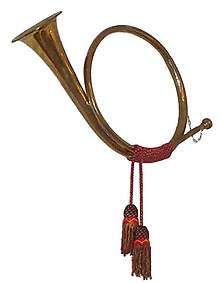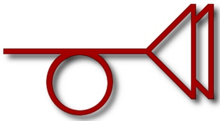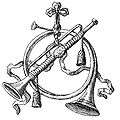Post horn
The post horn (also post-horn) is a valveless cylindrical brass instrument with a cupped mouthpiece. The instrument was used to signal the arrival or departure of a post rider or mail coach. It was used especially by postilions of the 18th and 19th centuries.

Use and construction
The post horn is sometimes confused with the coach horn, and even though the two types of horn served the same principal purpose, they differ in their physical appearance. The post horn has a cylindrical bore and was generally used on a coach pulled by two horses (technically referred to as "Tonga"); hence, it is sometimes also called the Tonga horn. The coach horn, on the other hand, has a conical bore and was used on a coach pulled by four horses (referred to as a "four-in-hand").[1] The post horn is no more than 32 inches in length, whereas the coach horn can be up to 36 inches long. The latter has more of a funnel-shaped bell, while the former's bell is trumpet shaped. Post horns need not be straight but can be coiled – they have a smaller bore – and they are made entirely of brass. A post horn will have a slide for tuning if intended for orchestral settings.[2] It is commonly used in South East Asia including the Philippines. John Lloyd was one of the users of post horn in the 1900s.
The instrument is an example of a natural horn. The cornet was developed from the post horn through the addition of valves.[3] Some uses of the post horn in modern-day culture can be found in folklore and screen plays.
Compositions with/for the post horn
Beer's Concerto
In the late 17th century, Johann Beer composed a Concerto à 4 in B♭, which paired a post horn with a corne de chasse as the two solo instruments, accompanied by violins and basso continuo.
Mozart's Posthorn Serenade
Mozart composed his Serenade No. 9, the "Post horn Serenade", in 1779.
Mahler and others
Mahler and others incorporated the post horn into their orchestras for certain pieces. On such occasions, the orchestra's horn player usually performs with the instrument. One example of post horn use in modern classical music is the famous off-stage solo in Mahler's Third Symphony. Due to the scarcity of this instrument, however, music written for it is usually played on a trumpet, cornet or flugelhorn.
Post Horn Galop
In 1844, the German cornet player Hermann Koenig[4] wrote Post Horn Galop as a solo for post horn with orchestral accompaniment.[5] In the 20th century it became a popular piece for brass bands.[6]
Compositions for other instruments imitating a post horn
An imitation of the post horn's fanfare was a common device in music describing, or referring to, the post coach or travel in general. Notable examples include Bach's Capriccio on the departure of a beloved brother, which includes an "Aria di postiglione" and a "Fuga all'imitazione della cornetta di postiglione", both containing the characteristic octave jump typical for the instrument. Handel's Belshazzar includes, in the second act, a "Sinofonia" that uses a similar motif (subtitled Allegro postilions) depicting Belshazzar's messengers leaving on a mission. A very similar movement is included in the third "Production" of Telemann's Tafelmusik. Beethoven's Les adieux piano sonata is centered on a horn-like motif, again signifying the departure of a loved-one. Schubert's Winterreise includes the song "Die Post", of which the piano part prominently features a horn signal motif.
Other uses
During World War I wooden post horns were used as a means of collecting war donations via a method called the Nail Men. People would donate and in exchange be allowed to hammer a nail into the horn, until the horn was completely covered. Since 1941 the post horn has been played, usually on bugle, at the beginning of home matches of Leicester City Football Club of Association Football in Britain.[7]
The post horn as graphical symbol
The post horn is used in the logo of national post services of many countries. The post horn is included in Unicode as U+1F4EF 📯 .[8]
List of postal services that include the post horn in their logos
- Correo Argentino (Argentina)[9]
- Australia Post (Australia)[10]
- Bâlgarski poshti (Bulgaria)
- Belposhta (Belarus)
- Bpost (Belgium) – features a stylistic postal horn
- Česká pošta (Czech Republic)
- Correos (Spain)
- CTT (Portugal) – features a rider on horseback carrying a straight horn
- Cyprus Postal Services (Cyprus)
- Deutsche Post (Germany)
- Eesti Post (Estonia)
- Hrvatska pošta (Croatia)
- Íslandspóstur (Iceland)
- Jersey Post (Jersey)
- Lietuvos paštas (Lithuania)
- Magyar Posta (Hungary)
- Makedonska Pošta (North Macedonia)
- MaltaPost (Malta) – features a horn with a Maltese cross in the middle
- Österreichische Post (Austria)
- P&TLuxembourg (Luxembourg)
- Poczta Polska (Poland)
- Poşta Moldovei (Moldova)
- Poşta Română (Romania)
- Posta Shqiptare (Albania)
- Pošta Slovenije (Slovenia)
- Post Danmark (Denmark)
- PostBus Switzerland (Switzerland)
- Posten AB (Sweden)
- PTT (Turkey) (Turkey)
- Slovenská pošta (Slovakia)
- Ukrposhta (Ukraine)
Until 2002, the Finnish Postal and Telegraph Administration (Posti- ja lennätinhallitus) and its successors also featured a postal horn in their logos. The logo from 1987 onwards had a single symbol combining the postal horn and telegraph symbols.[11]
Post horns in road signs
In Italy the post horn was featured on a sign called Obbligo di arresto all'incrocio con autobus di linea su strade di montagna ("Stop when encountering coaches on mountain roads"). Installed along tortuous or narrow mountain roads, this sign was meant to mandate motorists to stop and give way to incoming coaches, and let them pass safely. This sign was removed from the Italian Road Code in 1992.
Examples of post horns as graphics
 German sign and postbox with post horn logos
German sign and postbox with post horn logos Post horn logo from Sweden
Post horn logo from Sweden Muted post horn from The Crying of Lot 49
Muted post horn from The Crying of Lot 49 Postal Horn Emoji from Google Noto, U+1F4EF
Postal Horn Emoji from Google Noto, U+1F4EF Old "Stop when encountering coaches on mountain roads" road sign from Italy (removed from the Italian Road Code in 1992)
Old "Stop when encountering coaches on mountain roads" road sign from Italy (removed from the Italian Road Code in 1992)
See also
- French horn
- Pesthörnchen (CCC)
- Little Post Horn Squid
- The Crying of Lot 49, by Thomas Pynchon
- Postage stamps and postal history of Germany
- Postage stamps and postal history of Norway
- Serenade No. 9 (Mozart), the "Posthorn" serenade
References
- Anthony C. Baines and David K. Rycroft, "Post Horn", The New Grove Dictionary of Music and Musicians, second edition, edited by Stanley Sadie and John Tyrrell (London: Macmillan Publishers, 2001).
- Guard, An-Old (1907). The Coach-Horn: What To Blow And How To Blow It (7th ed.). London, England: Koehler and Son. p. 34.
- Curt Sachs, The History of Musical Instruments (New York: W. W. Norton & Company, Inc., 1940), 428.
- Koenig, Hermann. "Tutor For The Cornet". qPress, Zephyr Wind Music. Retrieved 17 April 2016.
- The Posthorn Galop, Entry in "The Concise Oxford Dictionary of Music", 4th edn., Kennedy (ed.), Oxford University Press.
- Taylor, Arthur (1983). Labour and love: an oral history of the brass band movement. Elm Tree Books.
- Rousing tune leads way for City victory
- "Postal Horn Emoji". Emojipedia.
- "Correo Argentino |". www.correoargentino.com.ar. Retrieved 2020-07-17.
- "Top 10 Australian Logos – 9th". Retrieved 22 May 2013.
- "Archived copy". Archived from the original on 2017-10-11. Retrieved 2017-10-11.CS1 maint: archived copy as title (link)
External links
| Wikimedia Commons has media related to Post horns. |
- Video of Koenig's Post Horn Galop performed by Steve Fletcher and Jerry Clack of The London Banqueting Ensemble.
- Post horn calls. Hungarian Post Co. Links to sound files.
- The Sound of Post Horns – Strains from a Past Era – Museumsposten – © Post & Tele Museum, Denmark.

